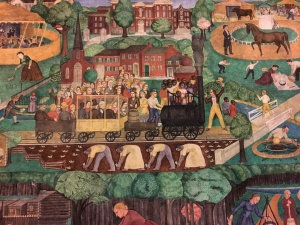Main Page: Difference between revisions
No edit summary |
No edit summary |
||
| Line 20: | Line 20: | ||
|date_of_action=November 25, 2015 | |date_of_action=November 25, 2015 | ||
|location=Lexington, Kentucky, United States of America | |location=Lexington, Kentucky, United States of America | ||
|description_of_content=Ann Rice O'Hanlon was a 20th-century American visual artist who painted murals. An alumna of the University of Kentucky, O'Hanlon painted a wall-length mural (fresco) inside the university's Memorial Hall in 1934 as part of the Treasury Relief Art Project | |description_of_content=Ann Rice O'Hanlon was a 20th-century American visual artist who painted murals. An alumna of the University of Kentucky, O'Hanlon painted a wall-length mural (fresco) inside the university's Memorial Hall in 1934 as part of the Treasury Relief Art Project with funds from the Works Progress Administration (WPA). The 11 x 38 foot fresco depicts the history of Kentucky through a series of vignettes, including explorers on the frontier, horse racing and scenes of downtown Lexington, the construction of log cabins, fishing off a bridge, passengers riding in a train, and horse training. It includes depictions of African-Americans picking tobacco in the fields, white people dancing to music played by black musicians, and a Native American peering from the woods at a white woman gathering water from a stream. | ||
|description_of_incident= | |description_of_incident=Students of color at the University of Kentucky objected to the mural. In a November 23 statement issued two weeks after a meeting with two dozen African-American students, University President Eli Capilouto related this comment: | ||
"One African American student recently told me that each time he walks into class at Memorial Hall he looks at the black men and women toiling in tobacco fields and receives the terrible reminder that his ancestors were enslaved, subjugated by his fellow humans. Worse still, the mural provides a sanitized image of that history." | "One African American student recently told me that each time he walks into class at Memorial Hall he looks at the black men and women toiling in tobacco fields and receives the terrible reminder that his ancestors were enslaved, subjugated by his fellow humans. Worse still, the mural provides a sanitized image of that history." | ||
On November 25, 2015, the administration covered the entire fresco in white | On November 25, 2015, the administration covered the entire fresco in white fabric. Capiluoto referred to the shrouding as an interim action, as a "long-term answer will take some time." Capilouto also created a task force made up of faculty, staff and students. | ||
|description_of_result= | |description_of_result=In response to the incident, the American poet, novelist, and activist Wendell Berry wrote an op-ed in the Lexington Herald-Leader denouncing the University of Kentucky’s decision: | ||
" | "The president...objects to the fresco on the grounds that it reminds 'one black student... that his ancestors were slaves.' That statement has at least two arresting implications: (1) that black students should not ever be reminded that their ancestors were slaves, and (2) that white students should not ever be reminded that their ancestors were slave owners. Do students, then, study history at our 'flagship university' in order to forget it?" | ||
In April 2017, the administration removed the drapery and the mural was once again visible; after nearly two years under wraps, the task force had concluded that the mural should be displayed, but with accompanying wall text to give historical context to the work. Signage describing its history, including the concerns voiced about it over the years, was added nearby. | |||
In a blog post, UK President Capilouto stated: | In a blog post, UK President Capilouto stated: | ||
Revision as of 20:50, 21 April 2017
|
